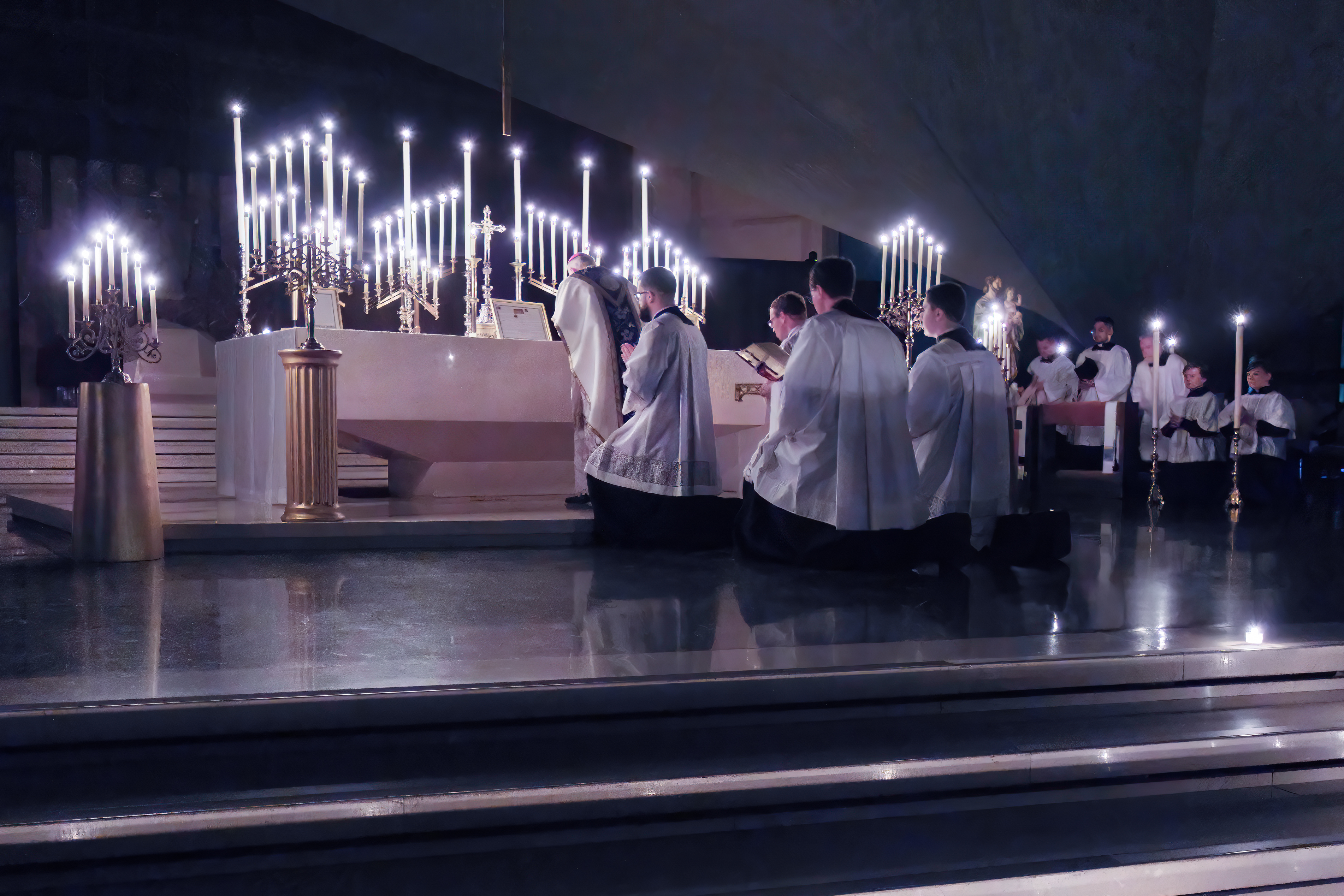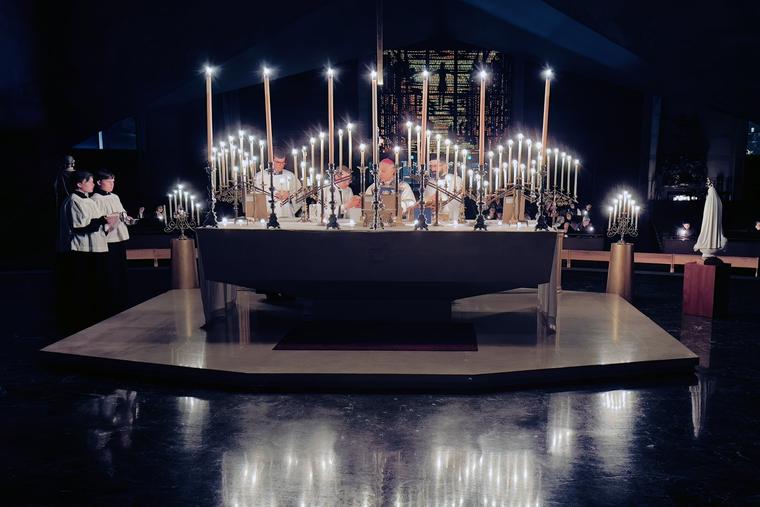San Francisco Archbishop Salvatore Cordileone plans to celebrate a solemn pontifical Latin high Mass at Star of the Sea Catholic Church in San Francisco at noon Saturday, Nov. 1, which is All Saints’ Day.
Pontifical Masses are celebrated by a bishop; the “pontiff” in this case refers to any bishop, not just the pope. A solemn pontifical high Mass in the traditional Latin Rite is a rare form of the Mass.
The solemn pontifical high Mass is the most elaborate of the Tridentine Rite Masses. A description of it takes up 20 pages in Adrian Fortescue’s 1920 book The Ceremonies of the Roman Rite Described.
Archbishop Cordileone’s Mass planned for San Francisco on Saturday, Nov. 1, is one of five traditional pontifical Latin liturgies scheduled for the next month, as the Register recently reported.
The others are Cardinal Matteo Zuppi’s pontifical vespers at the Basilica of San Lorenzo in Rome on Friday, Oct. 24; Cardinal Raymond Burke’s pontifical Mass at St. Peter’s Basilica in Rome on Saturday, Oct. 25; Cardinal Gerhard Müller’s pontifical Mass at Our Lady of Lourdes in Philadelphia on Sunday, Nov. 2; and Cardinal Robert Sarah’s pontifical vespers at the Cathedral-Basilica of Sts. Peter and Paul in Philadelphia on Friday, Nov. 21.
The Register spoke by telephone with Archbishop Cordileone about the upcoming Mass in San Francisco. This interview was edited for clarity and length.
Why is the pontifical Mass occurring in the Archdiocese of San Francisco?
It’s occurring because we have a parish here that’s hosting a Rosary congress. There’s a movement of people. And they wanted to bring it here to San Francisco, a Eucharistic Rosary congress. And one of our parishes is hosting it.
 Archbishop Cordileone’s Mass is set for Saturday, Nov. 1. (Photo: Dennis Callahan )
Archbishop Cordileone’s Mass is set for Saturday, Nov. 1. (Photo: Dennis Callahan )
They asked me to celebrate one of the Masses during the congress, and they wanted to have it at the cathedral. So I agreed to do it on All Saints’ Day. So this is a Saturday, Nov. 1. So that was all set.
Then they asked me if I would do it as a traditional Mass. And I said, “Well, I’m willing to do that, but if you want it done as a solemn Mass, our cathedral really isn’t set up for it. The liturgical space is inadequate to a traditional solemn high pontifical Mass.”
So I gave them three options. One, we would do the Novus Ordo Mass, as we had planned all along, and do it in a very traditional way. We’re already celebrating our parish Masses at the cathedral ad orientem, so it would be easy to do that, with lots of Latin and the classical chants, polyphony, and so forth.
Or, two, we could do what’s called the pontifical low Mass, or the bishop’s Mass with ceremony, so it’s a more solemn form of the low Mass, which I already do once a year. As it is, we have a Rorate Mass during Advent at the main altar in our cathedral. So we could do that. And there could be some music provided.
Or they could have a solemn high pontifical Mass. But if they wanted to have a solemn high pontifical Mass, it would have to be in the parish church, not in the cathedral. So I gave them the three options, and they chose the third. I was open to all three, so I was trying to respect what their desires were, and they chose the third.
Is that because the parish church has a high altar that’s suitable for it?
It’s because in a solemn high pontifical Mass there’s a throne set up on the Gospel side of the altar. So that’s as you’re looking at the altar; it’s on the left.
So in a traditional cathedral, that would be the bishop’s cathedra. Our cathedra is behind the altar, so it really doesn’t work liturgically in the older Mass to have, because the bishop, you know, he vests at the throne, and some part of the Mass takes place at the throne. And it really should be on the Gospel side, not behind the altar. So that’s why.
In the parish church, they can set up a throne on the side. We can’t do that. First of all, it wouldn’t make sense to set up a throne when there’s a cathedra there. Secondly, it wouldn’t work anyway because there’s an ambo there that would be in the way of the throne. So it just doesn’t work for the liturgical space. But it can work in the parish church.
How many pontifical high Latin Masses have you either been to or celebrated before?
Oh, I’ve celebrated a few of them, because I’ve been requested to do ordinations, both for the Institute of Christ the King, Sovereign Priest, and for the Priestly Fraternity of St. Peter. So I’ve done that a number of times. And there have been a few other times on other occasions. So, I don’t know, maybe 10 or so.
What are some of the highlights? What should people look for?
Well, it’s very ornate, obviously, and there are a lot of details in the ceremony, and there’s a lot of movement between the altar and the throne.
They should look for — oh, where to start? It begins with the bishop vesting. So the vestments are laid on the altar, and they’re brought to him, to vest. This is of very ancient origin, actually.
A lot of what we have in the solemn Mass — oh, I would say this, to people who are familiar with the Byzantine Rite: a lot we have in common with the Byzantine Rite.
 Archbishop Salvatore Cordileone at the altar celebrating the Pontifical Low Roráte Mass at the Cathedral of Saint Mary of the Assumption on Dec. 13, 2022. (Photo: Dennis Callahan )
Archbishop Salvatore Cordileone at the altar celebrating the Pontifical Low Roráte Mass at the Cathedral of Saint Mary of the Assumption on Dec. 13, 2022. (Photo: Dennis Callahan )
I was, about a month ago, at the ordination of a bishop for the Orthodox Church of America. And I saw a lot of similarities with our traditional Mass, including the vesting rites.
So the idea that vestments are brought from the altar, because the throne represents the bishop’s authority to govern his diocese — the muneris regendi, we would say, of the three munera. The altar represents his power to sanctify, the munus sanctificandi. So that’s the power of orders. All of its power of governance flows from the power of orders. So this is just the first point of symbolism in the Mass. So he vests at the throne, with the vestments brought to the altar.
There are lots of other details in the symbolism, where the epistle is sung, where the Gospel is sung from, the washing of the hands. So I would say to pay attention to all of these details. They all have symbolic significance.
Do you see it as a symbol of unity with Eastern Churches?
Yes, I do. I do. Because like I said, we have a lot more in common.
Also, before the calendar was revised, on the calendar, we had a lot more in common with the East than we do now.
You can’t erase the past, anyway. You can’t erase and go back. But I think we can retrieve some treasures that were lost. And I think that might build up more at least commonality, and, hopefully, God willing, some more unity with the East.
Would you like to see these types of Masses celebrated more often?
What I would like to see — and not necessarily the solemn high pontifical, it’s a beautiful Mass, and so should be available as appropriate — what I think would be helpful is if the traditional form of the Mass is familiar to most Catholics. Not necessarily that every Mass is a traditional Mass, but like it’s an ordinary part of Catholic life, because then we’re going to come to some kind of a mutual cohesion and a lot more harmony, the way people are drawn to worship.
Is there anything else you want to say about the pontifical solemn high Mass in Latin?
It teaches us a lot. So those who are interested, I would invite them to study what this Mass is about, and to learn it, and take it as a way of enhancing the worship — no matter which form of the Mass they worship in, to take it as an opportunity to enhance and deepen that worship.

